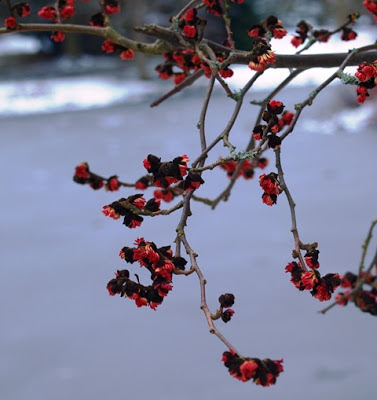Naked flowers a treat for botanists and squirrels
These are the flowers of the Persian Ironwood, Parrotia persica, before they were eaten by a squirrel in Kew Gardens.
This small tree from the Alborz Mountains of Persia, now Iran, is the only member of a genus named after the naturalist Freidriech Parrot from Livonia, now Lativia and Estonia. According to Wikipedia, his descendants now live in Australia, once called Terra Australis Incognita...
Persian Ironwood is closely related to Witch Hazel, and used to be included in the same genus, Hamamelis.
Our Kew app describes the wood as almost indestructible and the autumn leaves as unbeatable. Parrotia persica is one of a few unrelated trees called Ironwood due the firmness, let us say, of the wood. And it's largely grown for its deep red to purple autumnal colour. The trunk too is quite pretty, in this case a lovely green standing out strongly against the snow.
However it was the flowers that caught my attention last week. Partly because there is bugger all out in flower but also because they have an intriguing structure: lots of deep red stamens and no petals.
Not appealing to everyone perhaps but for a botanist and for squirrels, quite a treat. When I photographed this specimen near the lake in Kew Gardens there were four squirrels in nibbling away at the flowers and buds.
To a botanist the absence of petals in interesting. According to a 1999 study, petals have been 'lost' three times within this particular subfamily of the Hamamelidaceae. That is, the ancestors of Parrotia had flowers with petals but in the evolution of this and two other genera the flowers became what is called apetalous. Often the flowers are simply described as naked.
Clearly whatever pollinated them wasn't attracted by petals. Or perhaps the colour of the stamens attractive enough without bothering to putting energy into petals. It would be an advantage to not have flimsy petals in the kind of weather around these parts at the moment.
The only animal I saw visiting the flowers was the Grey Squirrel and it was hardly dainty enough to effect pollination.





Comments